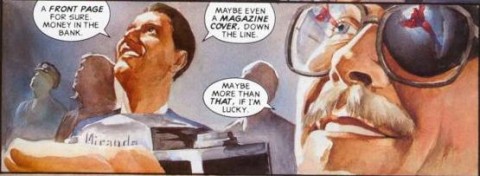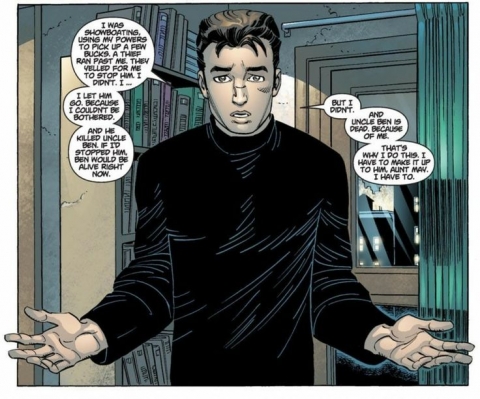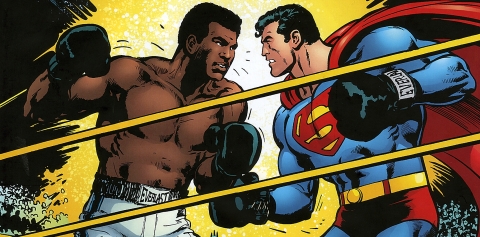52 weeks. 52 different writers. 2 trade paperbacks or hardcovers a week. Each week I’ll take a look at a different writer and read two different collected editions from within that person’s repertoire to help in the examination of their work. Kurt Busiek is this week’s writer as we take a look at the work he’s done with the biggest heroes within the DCU.
Kurt Busiek has had a storied career, having defining runs on books like Avengers, Astro City, Marvels, and so many more that it’d justify a single article to itself just to talk about them all. Back in 2008, Busiek was tasked with the monumental task of crafting a year long weekly series, Trinity, starring Superman, Batman, and Wonder Woman for DC Comics. The series was a rousing success and adapted a unique style of storytelling, splitting the book into two halves, replying heavily on the back-up story to help push the narrative for the series.
Trinity Volume 1
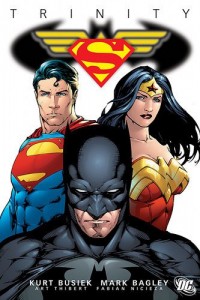 Trinity follows Superman, Batman and Wonder Woman as they deal with an arcane threat against the DC Universe. The three heroes all gather in Keystone City to touch base with each other following a peculiar dream that they all shared. When several strange things begin to occur across the planet Earth, the sense of connectivity between the three heroes only grows stronger as they try to root out the cause of this most recent disturbance. Their search sends them to seemingly every corner of the Earth as they discover a mystical attack is being launched against them. But how does a tarot card reader, Despero, Hawkman and several other random characters factor into these unknown plans against the Trinity?
Trinity follows Superman, Batman and Wonder Woman as they deal with an arcane threat against the DC Universe. The three heroes all gather in Keystone City to touch base with each other following a peculiar dream that they all shared. When several strange things begin to occur across the planet Earth, the sense of connectivity between the three heroes only grows stronger as they try to root out the cause of this most recent disturbance. Their search sends them to seemingly every corner of the Earth as they discover a mystical attack is being launched against them. But how does a tarot card reader, Despero, Hawkman and several other random characters factor into these unknown plans against the Trinity?
Trinity Volume 1 collects the first seventeen issues of the weekly series from 2008 that stars DC’s holy trinity of Superman, Batman and Wonder Woman. The story is told in a unique format for modern comics as each issue is divided into two separate parts, a twelve page story that follows the exploits of the Trinity followed by a ten page story that checks in with other parts of the DC Universe. Kurt Busiek crafts a large scale story that stretches out across the entire tapestry of the DC Universe, drawing in characters from street level vigilantism, to cosmic scale superheroes and even the magically inclined.
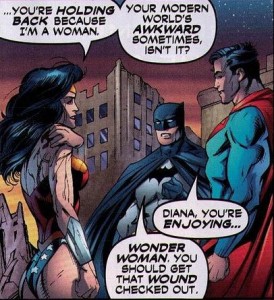
When talking about Trinity overall I feel as though it is easiest to talk about the bad before you get to the good, simply because the bad is a glaring part of the book stretches from the start to finish. Although it adapts a unique style of storytelling for comics, relying heavily on using “back up stories” (something that many modern comics lack), the narrative struggles to get off the ground every issue due to having a limited number of pages to tell a story. With the first twelve pages of every issue being about the Trinity, you’re bound to get excited because that’s where the meat of the story lies. The unfortunate truth though, is by the time you get to that twelfth page and start to feel invested, you’re cutoff and transitioned into the ten page back up story in the back half of every issue. The balancing act isn’t kind as the back-up stories don’t actually get interesting until about half way through the book. It’s a true disadvantage to use the last ten pages of the book to talk about characters within the DC Universe that you can’t really invest in.
Now when you examine the two different sets of story per issue on their own, they actually hold up much better. One can only wonder why DC didn’t just combine much of the Trinity into a much more seamless story and only cutaway to the back up stories when necessary for this collected format. The main Trinity story functions well enough on it’s own, keeping you informed plenty well enough along the way. Busiek does a fine job of investing us into the story of the bond between Superman, Batman and Wonder Woman over the seventeen issues we spend with them. The further you get into the tale, the more tightly bound they become due to the arcane nature of the attacks against them. You get to watch their personalities dissolve and actually switch amongst each other as Superman begins to take on characteristics of both Wonder Woman and Batman, and so on. It’s fun to see these personality shifts as it shakes up the conventional knowledge you have of these characters as you try to decipher which personality traits someone like Batman is taking on from other characters.
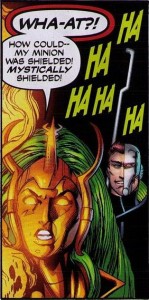
The back-up stories can easily be broken down into three separate stories, with two of them actually connecting together more tightly than the third of the bunch does. You follow Tarot for the first half of the book, the exploits of characters like Nightwing, Robin and Oracle in the second half, while in the last story you follow Hawkman, Gangbuster and the collective DC Universe. The Tarot and Hawkman stories actually serve as parts one and two to each other when you look at them closely while the vigilante section largely functions in its own playground and finds its own way to connect to the remainder of the story. The Tarot story is the weakest of the three as you’re introduced to a character that you can hardly feel an emotional connection to. When you get to the adventures of Nightwing and company you can’t help but pay attention due to the characters’ dynamic natures and general history in relation to the rest of the DC Universe. It’s like an immediate shot into the arm by Busiek who makes these characters fun to following along with.
Speaking of characters, the cast for this book is HUGE. Busiek seemingly uses every single heroic character from DC’s history in this volume. Not all of them have speaking lines but they are certainly there. Although your core cast consists of the Trinity, other characters like Hawkman, Tarot, Green Lantern, and Gangbuster have fairly significant roles to be played. Even beyond these characters, the Justice League from this time period factored in fairly regularly into the story, serving as solid back up for the group of heroes. In terms of villains, your primary three who are lashing out against the Trinity, Morgan Le Fey, Enigma, and Despero, are all uniquely motivated in their goals and have a few shocking secrets that only make reading this volume more interesting.
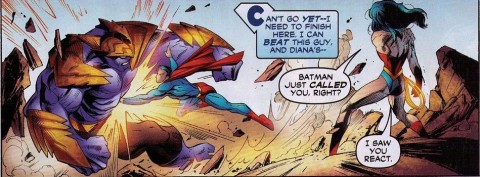
Collects: Trinity #1-17.
Best Character: Enigma.
Best Line Of Dialogue/Caption: “Maybe it doesn’t like concrete?” – Robin.
Best Scene/Moment: Earth 3 invasion – Issue 12.
Best Issue: Issue 16. Issue 16 is the winner because it largely concludes the first act of this massive, 52 issue story. You watch as the Trinity finally comes to blows with their mysterious foes and tries to thwart their plan that would unhinge the entire DC Universe. It’s thickly plotted, action packed and tons of fun to watch unfold.
Why You Should Read It: Kurt Busiek plays with some different concepts and tries to take modern storytelling in a new direction with Trinity. The result isn’t always award winning but ultimately you’re left with a story you can’t help but invest yourself into because of how massive in scope it really is. You’re exposed to so many different areas of the DC Universe that it’s hard to walk away without feeling attached to one character and what happens to them.
Marvels
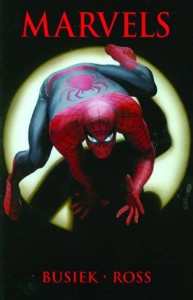 Kurt Busiek teamed up with Alex Ross to bring a whole new perspective to the comic world through Marvels. Everyone has seen the many historic moments that have occurred throughout Marvel’s history through the eyes of the superheroes who have experienced these events. But how often do you see one of these major, game changing moments through the eyes of a civilian? That’s exactly what Busiek did with Marvels, changing the comic landscape with a story from a civilian perspective unlike any other story done in comics up to that point. The story was only enhanced by the enamored artwork done by Alex Ross during this critically acclaimed miniseries.
Kurt Busiek teamed up with Alex Ross to bring a whole new perspective to the comic world through Marvels. Everyone has seen the many historic moments that have occurred throughout Marvel’s history through the eyes of the superheroes who have experienced these events. But how often do you see one of these major, game changing moments through the eyes of a civilian? That’s exactly what Busiek did with Marvels, changing the comic landscape with a story from a civilian perspective unlike any other story done in comics up to that point. The story was only enhanced by the enamored artwork done by Alex Ross during this critically acclaimed miniseries.
Set in the early years of the Mavel Universe, Marvels follows photographer Phil Sheldon over forty years of his life. The age of superheroes kicks into high gear as Sheldon begins to try and make headway in his career as a photographer. All around him, the world reacts and revolts to these new “Marvels”, something modern mankind has never seen or even heard of before. From beautiful moments of saving citizens to natural disasters, the Marvels bring just as much woe as they do joy to the world. Through Sheldon’s lens he captures how the general population reacts to the highs and lows of having a superhero driven world, using the images he gets to create a best selling book. But at what point does Sheldon have to stop before he sacrifices his family for his career?
Marvels does a magnificent job of humanizing superheroes whilst still placing them on a pedestal. This is a raw and authentic story from Kurt Busiek who taps into something that hadn’t really been done to this degree before in comics at the time of its release. Using the point of view of Phil Sheldon, a regular human, isn’t anything woefully unique but it’s Busiek’s approach to the character, and as such the characters approach to superheroes, that sets this story out as an instant classic. Marvels is a winner through and through. Obviously the story is more enjoyable if you’re a fan of the Marvel Universe but even on it’s own, ignoring all the history associated with Marvel, the story stands up on its own two feet beautifully. The history of this world and characters is important to the story and is largely the reason it all works in such a magnificent fashion but that doesn’t mean you need to be a Marvel historian to get what Kurt Busiek is laying the foundation for.
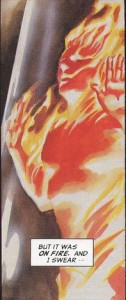 In my mind, the main point of this story is to show that these “Marvels”, these incredible things and people, can still have human qualities and be easy to relate to. It’s likely part of the reason that the story opens with a tale about the first Human Torch. A normal man who is driven by scientific curiosity turns his son into the Human Torch. He is lush with excitement over this amazing development only to be rejected for creating something unnatural. The story becomes told through the Human Torch’s point of view and you’re consumed by this saddening anxiety from this man who was changed and rejected. The effect is similar to something like Mary Shelley’sFrankenstein, with man rejecting what they believe to be a beast. Furthermore, you see more of this theme in every part of the story. Whether it is the prejudice towards the mutants, the horror of a hero like The Thing, or the tantalizing sorrow that creeps in surrounding Spider-Man’s greatest defeat, all these real emotions creep into these fictional characters.
In my mind, the main point of this story is to show that these “Marvels”, these incredible things and people, can still have human qualities and be easy to relate to. It’s likely part of the reason that the story opens with a tale about the first Human Torch. A normal man who is driven by scientific curiosity turns his son into the Human Torch. He is lush with excitement over this amazing development only to be rejected for creating something unnatural. The story becomes told through the Human Torch’s point of view and you’re consumed by this saddening anxiety from this man who was changed and rejected. The effect is similar to something like Mary Shelley’sFrankenstein, with man rejecting what they believe to be a beast. Furthermore, you see more of this theme in every part of the story. Whether it is the prejudice towards the mutants, the horror of a hero like The Thing, or the tantalizing sorrow that creeps in surrounding Spider-Man’s greatest defeat, all these real emotions creep into these fictional characters.
In telling the story through someone like Phil Sheldon, Busiek taps into the sense of humanity necessary to pull off a story like Marvels. You watch a young and hopeful Phil grow into a bitter old man, hardened by a life that has left him fickle. Through the story you ride the waves of the time period, watching as Phil, a man who wouldn’t harm a fly, gets caught up in things like mob mentality and actually tries to harm mutants even though it is outside of his usual characteristics. Then, a few scenes later, Phil is forced to help hide a young girl who is a mutant, taking upon his duty as a father to set a good example for his daughters who have actually been harboring the mutant. It’s all believably human for Phil to be conflicted at several sharp turns in the story where he has the option to go left or right and chooses to go with the flowing of how things are unfolding instead of just reacting repeatedly. The wonder of what’s happening around him is never lost, as there are so many pages where Phil is left in awe that you’ll lose count of them all by the end.
To give a character like Phil a job as a photographer is simply brilliant as it makes him the reader’s eyes to the entire story. We see these beautiful images through his lens and his perspective, getting swept up in the sheer beauty of everything that unfolds. How Busiek manages to inject so much humanity into one character is astounding as he manages to actually project Sheldon’s emotions on to you as a reader. The perfect example of this is a scene late in the book where Sheldon captures a fateful fight unfolding between Spider-Man and The Green Goblin for Gwen Stacey’s life. The fight isn’t what’s important about the scene. What makes this scene important is how closely it places a hero under the microscope of a normal man. We all know how that scene ends but Busiek does something incredible with the way he writes the scene, distilling a sense of hopefulness into Sheldon to convince the reader that Spider-Man might actually save the day, only to snatch it away in gut wrenching fashion. Everyone knows the story of Spider-Man and how Gwen Stacey dies but watching it play out through the eyes of a bystander who is heavily invested in the situation shines a whole new light on the scene. That is largely what you can expect from Marvels, as this new perspective will change the way you’ll look at plenty of classic Marvel stories. Marvels isn’t a story about superheroes, it’s a story about superheroes as seen through the eyes of regular people.
Collects: Marvels #0-4.
Best Character: Phil Sheldon.
Best Line Of Dialogue/Caption: “But there was something in her–in its eyes–and I couldn’t help thinking of the liberation of Auschwitz–and the look in her eyes–” – Phil Sheldon.
Best Scene/Moment: Gwen Stacey’s euphoria in the midst of chaos – Issue 4.
Best Issue: Issue 4. It feels a little unfair to just pick one issue that stands out from the pack for this one since the story works best in a flowing motion where you read one issue after another. With that said, it’s still an absolute pleasure to break up your reading and watch how much things change from issue to issue. To me, issue 4 perfectly captures the central themes and moods that Busiek was striving to accomplish and it serves as an excellent final chapter to the entire story. All that plus it features that scene with Spider-Man, Green Goblin, and Gwen Stacey that I gushed about above.
Why You Should Read It: Busiek does something marvelous here as he makes a great superhero story that isn’t about the superheroes so much as it is about how they effect the lives of regular people like you or I. For a work of fiction this feels incredibly humanizing. Every page feels real, dragging you further into the life and times of Phil Sheldon. To a further point, this book takes some of the biggest classic moments from Marvel Comics’ history and enhances them to a point where they might be better portrayed here than they were decades ago when they first occurred. All this AND the artwork is breathtakingly done by Alex Ross. How can you say no?

